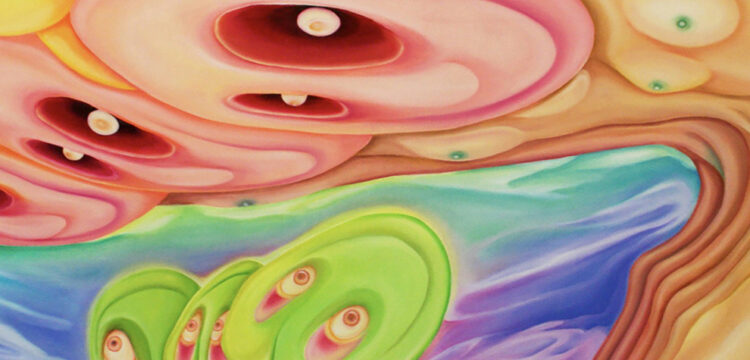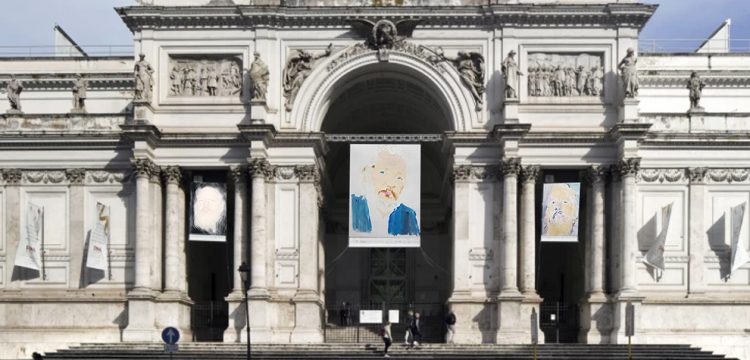The Trickster
An Archetype in Post-Internet Art: William Darkdrac “Nosce te ipsum” at 200CENT.
William Darkdrac’s (psychoudini) solo exhibition Nosce te ipsum at 200CENT (Barcelona) explores the trickster archetype as the artist’s alias in navigating the chaotic, deep-fried and post-ironic internet landscape.
In 1971, Italian artist Alighiero Boetti started working on Mappe: a series of political maps hand-woven by Afghan weavers, displaying the borders of the world by filling each country with the colors of its flag. The work done with Mappe is emblematic for the core concept on which the artistic production of Arte Povera insisted: the impossibility of archiving, and human kind’s attempt—a tender one, but doomed to failure—to chop up experience by dividing it into categories, labels, sections, catalogs; the desperate need to crystallize eternally elusive fragments of life. The essence of Boetti’s maps, in fact, lies in the opposition between the speed of change in world arrangements and the patient, meticulous and dilated action of weaving in order to freeze an image of the world in a precise time.
Most of post-internet figurative art seems to start from this same assumption, but translated into the anxiety towards the speed of what Hito Steyerl called “poor images”: the infinite amount of visual stimuli scattered in media landscapes, traveling at the speed of light while losing definition and settling in one’s layers of memory in ambiguous ways. Traveling the internet means to inhabit a landscape without any map to follow, where every configuration has its limits dissolved, erased, re-imagined, warped and repurposed in a new shape. What is often defined as post-internet figurative art—using Marisa Olson’s highly debated term referring to figurative art which appropriates, is inspired or is centered on the internet’s distinctive dynamics—comes in the form of the tension between the use of classic painting techniques and the representation of ephemeral images. Brush strokes, then, start aiming at recreating signs of digital image deterioration such as pixels, low poly, high-contrast (what happens for “deep-fried” images), and extreme stretching. Those processes are then subverted and stripped off of their very own rapidity and instability, now translated into something material.
These figurative artists reappropriate digital images such as memes, Instagram posts or video games, devirtualizing them and giving back a material life to them to—funnily enough—get them disseminated on the Internet again, in a short-circuit involving virtuality and its opposite. Instagram Archive @itsnotgallery leads a research about this “New Aesthetic” in the art world, while curator Paul Hamelin said he “found the artists by researching on Instagram” to put up the show Happy Accidents, which gathered post-internet figurative artists at Galeria Sultana, Paris.
Watching artists like Marilou Bal using oil paint to recreate the glitches of low-quality digital images is moving for the same reason why Boetti’s Mappe is: a desperate human attempt to restore materiality to a flow that runs too fast for it to ever get grasped. These artists’ attempt is, in some way, an attempt to trace some points and map the internet, and it is no coincidence if William Darkdrac’s exhibition Nosce te ipsum at 200CENT (Barcelona) is titled after a map.
William Darkdrac, who goes by the pseudonym of @psychoudini, is one of the artists promoted by @itsnotgallery’s archive, known for his airbrush paintings of medieval tricksters: an archetype he reiterates throughout his body of work, and also the center of his solo exhibition, which opened on the 17th of February this year, named after a mysterious map with no author and no precise date of creation.
Probably drawn during the late 16th century, the map which inspired Darkdrac, also known as “Nosce te ipsum”, is considered one of the greatest mysteries of Western cartography. It is a map wrapped in a large jester’s hat, the inscriptions on which refer to the literary theme of the laughing philosopher and the weeping philosopher: “Democritus of Abdera laughed, Heraclitus of Ephesus wept, Epictetus, citizen of the world, drew it.” Epictetus, of whom no other information is available, is probably an alias of the same author, who adds, at the very top of the map, the inscription “Among all the universe the Earth is nothing, this is the substance of our glory, this is our home, this is the place where we occupy positions of power and crave wealth, and throw mankind into turmoil, and make wars, even between civilians.” A reference to the transience of our world and of human life. For this reason, several scholars have understood this map as a critique of the lack of accuracy of cartographic representations of the time; in other words, a critique of the prevailing reality of time over the act of recording.
The jester is known to be the only one who could make fun at the court without being punished. The only one who, enjoying the reputation of a madman, could tell the truth. The trickster, or gambler, or jester, or fool, or buffoon, is the icon that most perfectly encapsulates the attitude needed to keep up with the surrendered humor of post-irony/post-cringe/post-sincerity cycles in the internet world; that realm that is equally deep fried, based, cringe and ironic, where language and meaning get continuously dissolved and re-semantized. But Nosce te ipsum wasn’t the only time we’ve seen internet art and the jester archetype directly meet: in 2023, artists Jon Rafman & Parker Ito presented their works at Lubov, New York for the exhibition Poets, Gamblers, Fools, whereas the curator Grant Tyler’s statement recites “Like a gambler the artist must learn to accept the potential for loss as a necessary aspect of the potential for gain. Like a fool the artist must walk innocently, ignorantly, and confidently into the unknown. History demands a poet, a gambler, a fool.”
Jay Islate’s collaborative film The Idiot, presented on June 11th, 2023 at The Metrograph in NYC, drew inspiration from the same connection. Inspired by Byung-Chul Han’s quote “One of the roles of philosophy is to play the fool or idiot,”—straight out his Psychopolitics: Neoliberalism and New Technologies of Power—the film is a collection of audiovisual artworks created by artists coming from online communities such as discord servers and chat rooms. In his statement, the curator suggests: “What happens to a psyche when faced with a world of hyper media fragmentation, post-identity, and post-posting? These are questions only the Idiot can answer. The Idiot, being set free from themselves and society itself, places themselves on the forefront of culture.”
The tricksterazion of culture, all the way from “post-truth in politics, mass distribution of fake news and pre-election informational wars” shows why the medieval court-jester is so appealing as an archetype for those who desire to navigate and interpret the contemporary media landscape. Sometimes, that may lean more on the Edgelord side, by causing debates and being directly inflammatory, while other times embracing the mysteries of an actual court Jester, raising questions but remaining ambiguous, exactly like William Darkdrac does.
In Bladee’s 2021 album The Fool, the drain gang hero and internet-infused musician imagines himself as the court madman by singing words such as “I guess I’m just the fool, I don’t know anything” (The Fool Intro). In the eight track BBY, however, he sings “How could I lose when I exist in something I made?” meaning he’s able to manipulate reality around him like a chaos magician. Maybe that’s what being a jester is really about: making fun of whoever thinks about reality as objective and dissectible, easy to map and divide into categories. Being an artist today means to be able to navigate the chaos using buffoonery to reflect on the attempt of recording the unstoppable flux, and it could look like the effort in giving back materiality to ephemeral images, just like Boetti did with his hand-woven ephemeral geopolitical borders.





